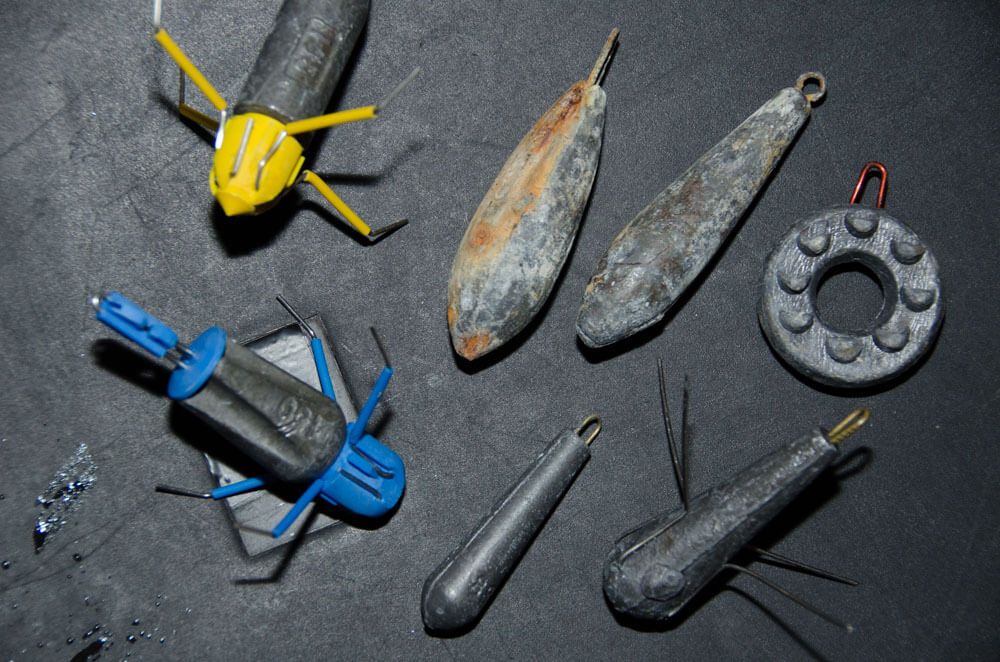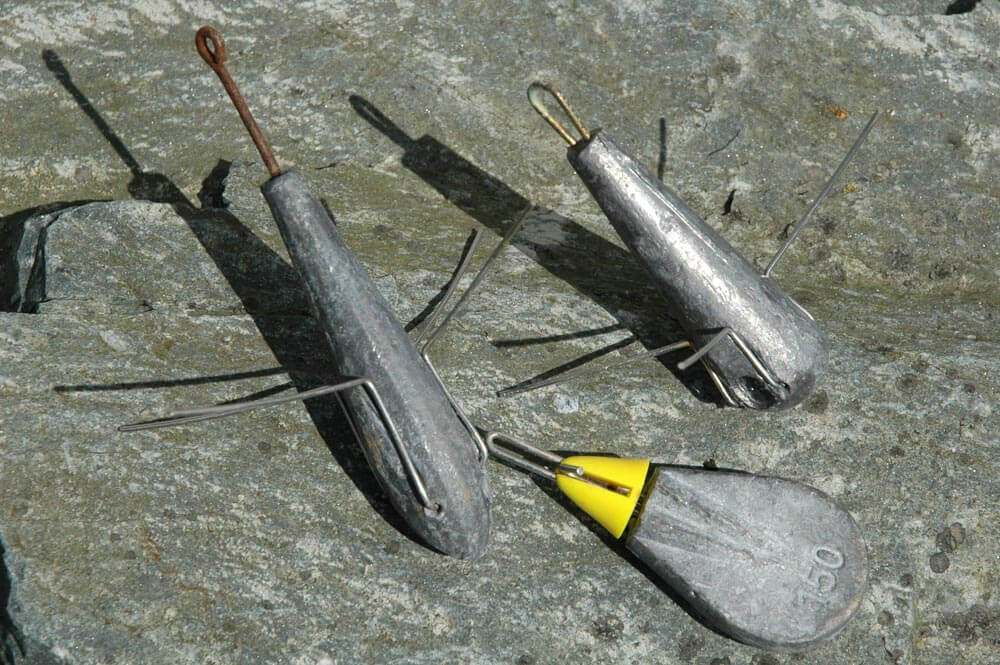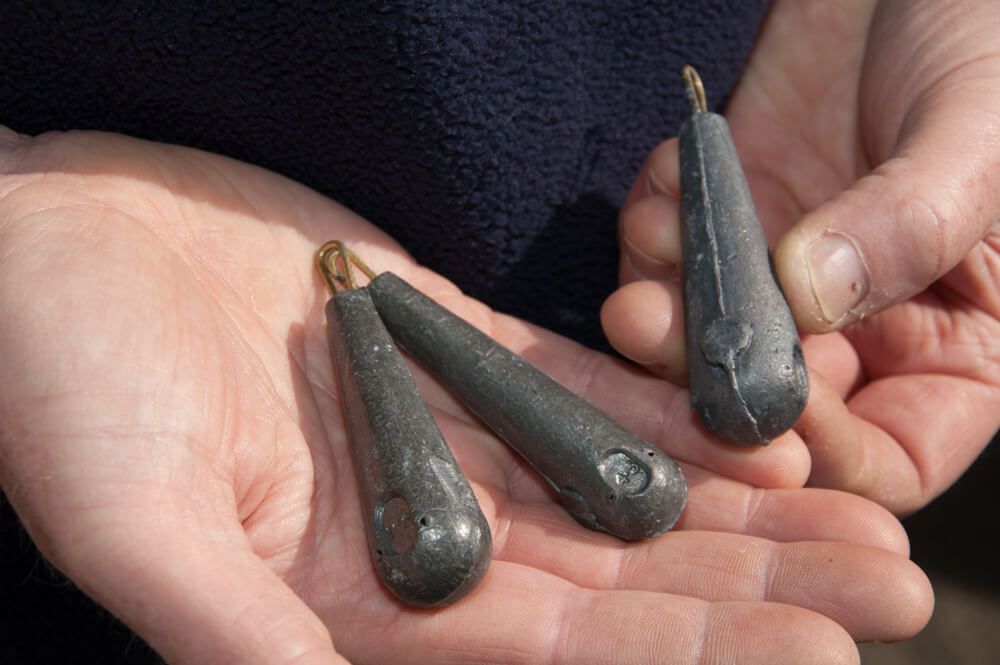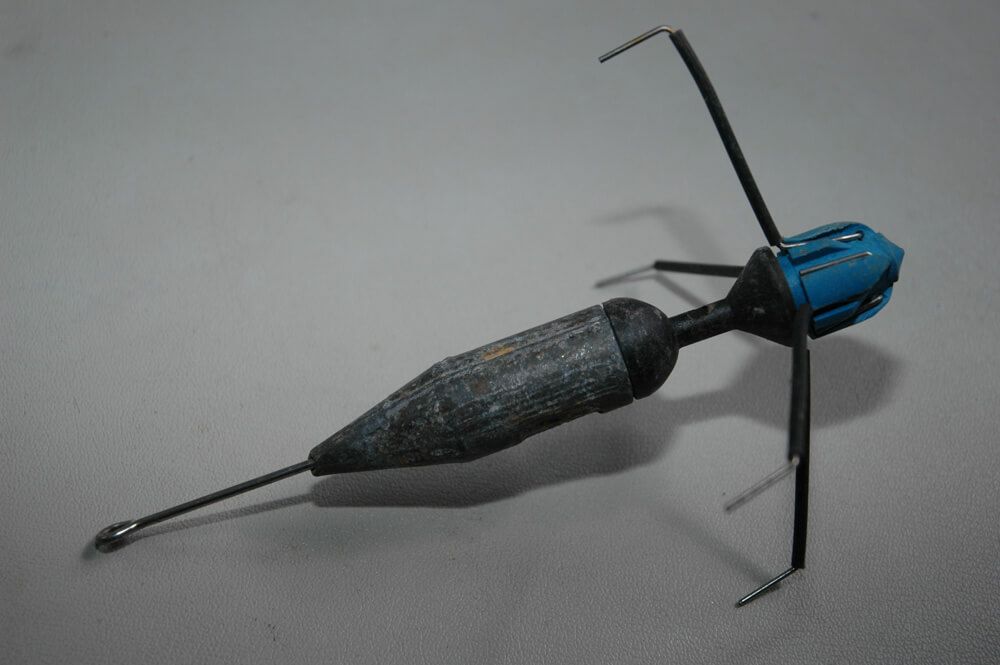Lead is a lead, right? Wrong! The wide range of lead shapes, be they for shore or boat, certainly gets confusing. If you're not sure which pattern to choose, then this feature will highlight most of the more common types and assess performance and versatility.

BREAKAWAY RELEASE WIRE LEAD
This was the main instigator in the huge revolutionary leap forward made in angling techniques during the late 60's and early 70's. It allows a bait to be anchored to the seabed whilst fishing, but once enough line pressure is applied, the wires fold forward and release their grip. The lead is retrieved as a plain lead with no wires would be. Before this, leads only had fixed wires which had to be dragged all the way back across the seabed resulting in snagged tackle and lost fish.
The original had beads fitted to the wires which sat in a recess moulded in the lead to give grip. By closing or opening the wires at the leads nose, this gives a degree of tensioning, which can be increased when necessary by adding a rubber band tied to one wire and then wrapped around the nose over the wires below the bead to give more grip before release. Similar leads used plastic or nylon sleeving instead of beads.
The pattern type is available now, both original and copied, in sizes from 2ozs upto 8ozs. It proves ideal for all beach casting situations, and also when uptiding off the boat.
BREAKAWAY EXTRA UPTIDE LEAD
Similar to the standard Breakaway lead, but although it retains the bomb shaped body, the nose slims down quickly into a bullet shape. The slim nose is again recessed to take beads fitted to the wires to give adjustable tension.
Designed for uptide casting from the boat, it gives excellent grip thanks to it's drag reduced profile and also proves a popular choice now for beach anglers who find it good fished into storm tossed seas when some other designs fail to hold in.
GEMINI SINKER
Differs from all other leads having a high impact plastic nose with notches moulded into it which allows the release wires to be clipped in and out at will. No need for beads and rubber bands. The lead body is moulded around a wire stem with screw threads in the end. The nose then screws down on this.
This design is sold as a complete kit for home moulding and you have the choice of plain noses for rolling leads and long stem noses for uptiding etc. Offers good grip and casting efficiency, both for shore and boat fishing.

TORPEDO
The Torpedo is one of the most common shapes used in lead design, especially beach leads. It is fairly aerodynamic, but the fattened end does create wind resistance during the cast which can lose you yards of the total distance. In a fishing situation this is negligible.
They are sold plain, or with recessed hollows and drilled holes in the body to take beads and release wires. Their shape gives them slight seabed grip even without wires, which allows the option of keeping a bait static for short periods, but then moving it back a couple of feet to add movement to the bait and to create interest from nearby fish. The same applies when boat fishing.
DCA TOURNAMENT ZOOM
This lead came about through the rapid escalation in interest towards tournament casting. The head end carries the bulk of the weight, but the head quickly tapers to a dull point which allows the air to be cut and then flow over the head area creating the minimum amount of drag whilst the lead is in flight. The body is long and tapers away much more slowly at the rear.
This is the ultimate lead for all long distance fishing, be it with a plain lead to allow the bait to roll, or when using release wires. Again, it's performance makes it a good choice for uptide work from the boat.
LONG TAILED LEADS
All the torpedo type patterns gain increased anchorage by having the tail wire lengthened anything up to 3-inches (7.5cms). This works like the chain on an anchor. It helps pull the lead in flat along the seabed which buries the wires deep into the sand or shingle.
This modification is an excellent option to have if you need to fish seas angered by gales when after winter cod or summer bass. The tails extra length also allows a bait clip to be fitted on it which gives increased casting distance by keeping the bait in the dead air zone as the lead flies, and also improved bait presentation for the same reason.
BOMB
In it's plain form it proves excellent for allowing a bait to drift with the tide and to seek out all the food holding areas that a static bait misses thanks to it's roughly egg shaped design. It casts well too, because the weight is condensed in a short length and concentrated towards the head. For sheer air cutting capability it's the best choice for casting into the teeth of a gale and still offers a high degree of anchorage when fitted with release wires and a long tail.
The same pattern, fitted with a small eye, works underneath a redgill flying collar rig when the tide run is not that great. It's shape makes it easy to retrieve then drop back when fishing this way.

DCA AQUAPEDO
This has four flat sides, the body tapering off slowly at the back and quickly at the nose. Mainly used as a boat lead for general downtide fishing, but because of the flattened sides it will sit on the sand or seabed and hold on it's own in a gentle tide. When it does start to move it slides, or may roll very slowly. This can create small puffs of sand that can attract fish towards the bait in clearish water.
It is rarely used by shore anglers, yet, due to the flat sides giving a small amount of grip without wires, it makes a good choice for slack water fishing from rocks onto clean sand and from steep to beaches when an occasionally moved bait will take more fish.
WATCH LEAD
A very old design dating back to the turn of the century, maybe before. Obviously round in shape, but with grip points around the circles flattened edges. These are designed to dig into the sand and offer a degree of grip. It does too, but more because the sane buries over the lead and helps hold it down.
It is the most popular choice when fishing a baited spoon for plaice in the spring. The points stir up the sand as the lead moves with the boats drift and again attracts fish towards it. It can spin and revolve when retrieved in a tide run. Not a good choice for any casting situations.
PLATE LEAD
As the name suggests, shaped like a plate with flat, solid sides. Rarely seen nowadays, but was once a very popular pattern. It loses out by spinning when retrieved, and on the drop will slide off at angles instead of dropping straight down due to it's flattened sides.
Another lead that can be used when baits need to be moved across the seabed. Shore anglers fishing estuaries may still find this pattern useful when flounder fishing at close range. Some big bass anglers also use because it quickly buries it'self in the sand and becomes invisible to a feed fish in clear water, and because it's wide and flat does not snag so easily over rougher ground.
DCA BO-PEDO
Roughly diamond shaped, but with flattened sides tapering into a rounded nose. It is designed for deep water work off the boat. It drops cleanly without sideways twist, and due to the weight being packed towards the head, retrieves well, too. It's holding power is obviously governed by the weight matched to the tide.
A good choice for all heavy ledgering over varied types of seabed contour. Works well on the drift, also. To gain extra holding power in rapid tides, you can add a nose wire at the moulding stage which can be formed into an eye and take a second BO-PEDO in tandem. This gives excellent holding power, but still retrieves well and drifts across the bottom if required.
THE BELL
You've guessed it, it's bell shaped! Sinks like a stone and is often chosen for deep water situations. It's not a good holding lead and can quickly be turned over on its side and will then roll easily. Okay if you're fishing as a pair from a dinghy, but can result in horrific tangles when fishing as part of a chart boat party.
The other disadvantage is that is has massive water resistance when being retrieved. You can feel the lead spiralling and fluting from side to side. It gives the impression of a hooked fish fighting. Okay as an expendable lead over deep water and rough ground, but a bad choice over sand.
SPIRAL LEADS
Another pattern little seen these days, but one that has a lot of use to the boat angler. It is a long tapered shaped, rounded, with a continuous slot spiralling around it's length and wire coiled into tight turns at each end.
The idea is to wrap the line inside the coiled wire, then along the groove in the body, and again through the wire at the other end which holds it in place. This means that you can add or remove the lead without breaking down the tackle. It has application offshore when drifting for turbot, plaice and rays, and is also useful in the smaller sizes as a weight under float tackle both on shore and on the
boat. Some anglers prefer this as a weight to be worked infront of a redgill sandeel when casting. It's tapered water and aerodynamic shape make it easy to retrieve and allows the eel to work correctly.
SPUTNIKS
Named after the first Russian satellites due to long grip wires positioned in the nose giving it a similar appearance. Normally a bomb or Aquapedo shape and designed purely for uptide work in ultra fast tides.

The four nose wires need to be about 6 or 7-inches (18cms) long. They travel straight out of the nose for 2-inches (5cms) and are held together with either wire or plastic sleeving, then are bent at right angles to the nose for a further 3-inches (7.5cms), then have the ends bent at right angles again back towards the lead to form grips that dig deep into the seabed.

BREAKAWAY RELEASE WIRE LEAD
This was the main instigator in the huge revolutionary leap forward made in angling techniques during the late 60's and early 70's. It allows a bait to be anchored to the seabed whilst fishing, but once enough line pressure is applied, the wires fold forward and release their grip. The lead is retrieved as a plain lead with no wires would be. Before this, leads only had fixed wires which had to be dragged all the way back across the seabed resulting in snagged tackle and lost fish.
The original had beads fitted to the wires which sat in a recess moulded in the lead to give grip. By closing or opening the wires at the leads nose, this gives a degree of tensioning, which can be increased when necessary by adding a rubber band tied to one wire and then wrapped around the nose over the wires below the bead to give more grip before release. Similar leads used plastic or nylon sleeving instead of beads.
The pattern type is available now, both original and copied, in sizes from 2ozs upto 8ozs. It proves ideal for all beach casting situations, and also when uptiding off the boat.
BREAKAWAY EXTRA UPTIDE LEAD
Similar to the standard Breakaway lead, but although it retains the bomb shaped body, the nose slims down quickly into a bullet shape. The slim nose is again recessed to take beads fitted to the wires to give adjustable tension.
Designed for uptide casting from the boat, it gives excellent grip thanks to it's drag reduced profile and also proves a popular choice now for beach anglers who find it good fished into storm tossed seas when some other designs fail to hold in.
GEMINI SINKER
Differs from all other leads having a high impact plastic nose with notches moulded into it which allows the release wires to be clipped in and out at will. No need for beads and rubber bands. The lead body is moulded around a wire stem with screw threads in the end. The nose then screws down on this.
This design is sold as a complete kit for home moulding and you have the choice of plain noses for rolling leads and long stem noses for uptiding etc. Offers good grip and casting efficiency, both for shore and boat fishing.

TORPEDO
The Torpedo is one of the most common shapes used in lead design, especially beach leads. It is fairly aerodynamic, but the fattened end does create wind resistance during the cast which can lose you yards of the total distance. In a fishing situation this is negligible.
They are sold plain, or with recessed hollows and drilled holes in the body to take beads and release wires. Their shape gives them slight seabed grip even without wires, which allows the option of keeping a bait static for short periods, but then moving it back a couple of feet to add movement to the bait and to create interest from nearby fish. The same applies when boat fishing.
DCA TOURNAMENT ZOOM
This lead came about through the rapid escalation in interest towards tournament casting. The head end carries the bulk of the weight, but the head quickly tapers to a dull point which allows the air to be cut and then flow over the head area creating the minimum amount of drag whilst the lead is in flight. The body is long and tapers away much more slowly at the rear.
This is the ultimate lead for all long distance fishing, be it with a plain lead to allow the bait to roll, or when using release wires. Again, it's performance makes it a good choice for uptide work from the boat.
LONG TAILED LEADS
All the torpedo type patterns gain increased anchorage by having the tail wire lengthened anything up to 3-inches (7.5cms). This works like the chain on an anchor. It helps pull the lead in flat along the seabed which buries the wires deep into the sand or shingle.
This modification is an excellent option to have if you need to fish seas angered by gales when after winter cod or summer bass. The tails extra length also allows a bait clip to be fitted on it which gives increased casting distance by keeping the bait in the dead air zone as the lead flies, and also improved bait presentation for the same reason.
BOMB
In it's plain form it proves excellent for allowing a bait to drift with the tide and to seek out all the food holding areas that a static bait misses thanks to it's roughly egg shaped design. It casts well too, because the weight is condensed in a short length and concentrated towards the head. For sheer air cutting capability it's the best choice for casting into the teeth of a gale and still offers a high degree of anchorage when fitted with release wires and a long tail.
The same pattern, fitted with a small eye, works underneath a redgill flying collar rig when the tide run is not that great. It's shape makes it easy to retrieve then drop back when fishing this way.

DCA AQUAPEDO
This has four flat sides, the body tapering off slowly at the back and quickly at the nose. Mainly used as a boat lead for general downtide fishing, but because of the flattened sides it will sit on the sand or seabed and hold on it's own in a gentle tide. When it does start to move it slides, or may roll very slowly. This can create small puffs of sand that can attract fish towards the bait in clearish water.
It is rarely used by shore anglers, yet, due to the flat sides giving a small amount of grip without wires, it makes a good choice for slack water fishing from rocks onto clean sand and from steep to beaches when an occasionally moved bait will take more fish.
WATCH LEAD
A very old design dating back to the turn of the century, maybe before. Obviously round in shape, but with grip points around the circles flattened edges. These are designed to dig into the sand and offer a degree of grip. It does too, but more because the sane buries over the lead and helps hold it down.
It is the most popular choice when fishing a baited spoon for plaice in the spring. The points stir up the sand as the lead moves with the boats drift and again attracts fish towards it. It can spin and revolve when retrieved in a tide run. Not a good choice for any casting situations.
PLATE LEAD
As the name suggests, shaped like a plate with flat, solid sides. Rarely seen nowadays, but was once a very popular pattern. It loses out by spinning when retrieved, and on the drop will slide off at angles instead of dropping straight down due to it's flattened sides.
Another lead that can be used when baits need to be moved across the seabed. Shore anglers fishing estuaries may still find this pattern useful when flounder fishing at close range. Some big bass anglers also use because it quickly buries it'self in the sand and becomes invisible to a feed fish in clear water, and because it's wide and flat does not snag so easily over rougher ground.
DCA BO-PEDO
Roughly diamond shaped, but with flattened sides tapering into a rounded nose. It is designed for deep water work off the boat. It drops cleanly without sideways twist, and due to the weight being packed towards the head, retrieves well, too. It's holding power is obviously governed by the weight matched to the tide.
A good choice for all heavy ledgering over varied types of seabed contour. Works well on the drift, also. To gain extra holding power in rapid tides, you can add a nose wire at the moulding stage which can be formed into an eye and take a second BO-PEDO in tandem. This gives excellent holding power, but still retrieves well and drifts across the bottom if required.
THE BELL
You've guessed it, it's bell shaped! Sinks like a stone and is often chosen for deep water situations. It's not a good holding lead and can quickly be turned over on its side and will then roll easily. Okay if you're fishing as a pair from a dinghy, but can result in horrific tangles when fishing as part of a chart boat party.
The other disadvantage is that is has massive water resistance when being retrieved. You can feel the lead spiralling and fluting from side to side. It gives the impression of a hooked fish fighting. Okay as an expendable lead over deep water and rough ground, but a bad choice over sand.
SPIRAL LEADS
Another pattern little seen these days, but one that has a lot of use to the boat angler. It is a long tapered shaped, rounded, with a continuous slot spiralling around it's length and wire coiled into tight turns at each end.
The idea is to wrap the line inside the coiled wire, then along the groove in the body, and again through the wire at the other end which holds it in place. This means that you can add or remove the lead without breaking down the tackle. It has application offshore when drifting for turbot, plaice and rays, and is also useful in the smaller sizes as a weight under float tackle both on shore and on the
boat. Some anglers prefer this as a weight to be worked infront of a redgill sandeel when casting. It's tapered water and aerodynamic shape make it easy to retrieve and allows the eel to work correctly.
SPUTNIKS
Named after the first Russian satellites due to long grip wires positioned in the nose giving it a similar appearance. Normally a bomb or Aquapedo shape and designed purely for uptide work in ultra fast tides.

The four nose wires need to be about 6 or 7-inches (18cms) long. They travel straight out of the nose for 2-inches (5cms) and are held together with either wire or plastic sleeving, then are bent at right angles to the nose for a further 3-inches (7.5cms), then have the ends bent at right angles again back towards the lead to form grips that dig deep into the seabed.

